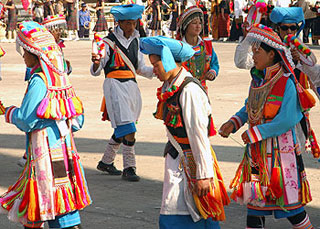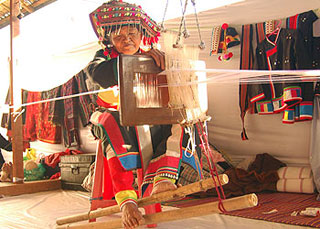The Lisu people are an ethnic group who inhabit in Myanmar. China. Thailand. and the Indian state of Arunachal Pradesh. They are also known as Yawyin or. in a few places Yobin. However. this is a derogatory term meaning ‘savage’ used by the Kachin of the Lisu; and was used by the Chinese of the Kachin before them. The Lisu are believed to originate from eastern Tibet but some assumes they moved to eastern Tibet/northwestern Yunnan in the 18th century. Not long after that. in the early 19th century. Lisu peoples began moving southwards down the Salween River Valley into northern Myanmar and northern Thailand.


The Lisu form one of the 136 ethnic groups officially recognized by Myanmar. Some 30.000 live in Thailand. where they are one of the six main hill tribes.
Villages of this colourful ethnic group are to be found in the mountains of China. Myanmar and northern Thailand. The Lisu make their clothing from gaily-coloured cloth stitched into outfits trimmed with row upon row of vari-coloured strips of cloth. The women wear brightly coloured costumes. consisting of aa blue or green parti- coloured knee length tunic with a wide black belt and blue or green pants. Sleeves shoulders and cuffs are heavily embroidered with narrow. horizontal bands of blue. red and yellow. The more affluent wear massive amounts of hand-crafted silver ornaments for festive occasions.
Lisu men produce crossbows. musical instruments. bird and animal trapss. and other items made of wood. bamboo and rattan. A few Lisu people have been converted to christianity by western missionaries. The Lisu believe strongly in the spirit world. and their shamans are used to divine the causes and cures of all problems and sickness. These hilltribe people are perhaps the best looking of all the tribes. and they like to think of themselves a little bit above their other hilltribe neighbors. They are among the least bashful of these ethnic groups and in general adjusting well to the changes taking place in their society. Their religion is part animist and ancestor worship. curing took place through shamanism. Traditionally living in villages high in the mountains or in mountain valleys. Western missionaries have attempted to convert them to Christianity. However. some Lisu converted to Protestant Christians starting in the early 20th century. The first Lisu to be reached by Christian missionaries were the Salween branch of the Lisu in Yunnan Province. China. Some Lisu have resisted the missionary change. as they opine that Christianity subjects their original religion and culture to gradual decay.


Lisu villages are usually built close to water to provide easy access for washing and drinking. Their homes are usually built on the ground and have dirt floors and bamboo walls. although an increasing number of the more affluent Lisu are now building houses from wood or even concrete.
Lisu subsistence was based on mountain rice. fruit and vegetables. However. they have typically lived in ecologically fragile regions that do not easily support subsistence. They also faced constant upheaval from both physical and natural disasters.
Lisu women are remarked for their brightly colored dress. They wear a multi-colored knee-length tunics of red. blue or green with a wide black belt and blue or black pants. Sleeve shoulders and cuffs are decorated with a dense applique of narrow horizontal bands of blue. red and yellow. Men wear baggy pants. usually in bright colours but normally wear a more western type of shirt or top.
Their language is Tibeto-Burman of the Loloish family. so closely related to Lahu. Akha. and Yi. However. they often incorporate vocabulary from the language of their dominant neighbors.
